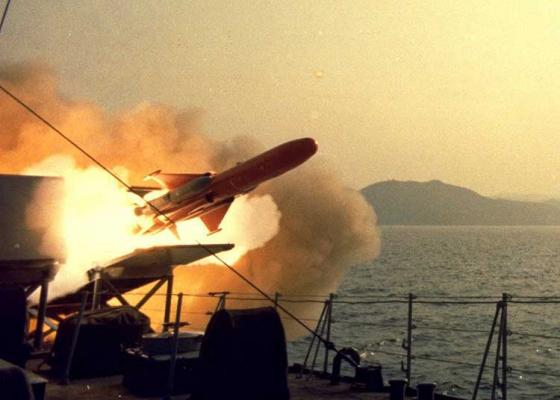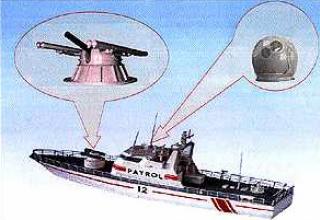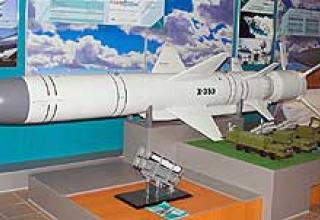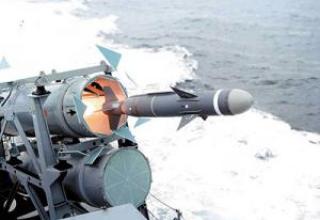"Otomat is an all-weather long-range anti-ship missile system with an active homing radar head and is in service with the naval forces of Italy, France, Egypt, Italy, Libya, Peru, Venezuela and other countries.
It was developed by the French company Matra Defense (now MBDA) together with the Italian firm OTO Melara.
The Otomat rocket was adopted for service in spring 1973. At the same time, missiles were supplied to the Italian Navy. Mass production began in mid 1973. The US also studied the possibility of taking the Otomat missile as a replacement or addition to the Harpoon anti-ship system (being developed in the US at that time). Several small batches were purchased by the United States, but they were not accepted for service.
The Otomat anti-ship missile has three versions of the Mk1 (1973), Mk2 (1982) and Mk3 (1989), which outwardly do not differ much from each other.
Composition:
The aerodynamic scheme of the Otomat rocket (see the scheme) is normal with fixed cruciform wings and tail rudders. The fuselage of the "Otomat" rocket is divided into 5 compartments: the head unit, combat unit, onboard control and guidance system, fuel and marching engine.
In the head compartment is an active type radar homing head, whose antenna scans in two planes and has a deviation angle of +20 °. Onboard control and guidance system provides target pointing within +200°, which practically does not require additional maneuvering from the carrier ship. The homing head uses a converted antenna type "Cassegrain" and superheterodyne receiver with automatic frequency control.
Before starting, the coordinates of the carrier ship and the target ship are entered in the onboard computer. The rocket is launched from a special container using two launch accelerators at an elevation angle of 18°-20°. The accelerators are separated at a distance of 0.6 km from the launch vehicle at an altitude of 160 m at a flight speed of 1100 km/h. In this section, the missile can make U-turns of more than 180° to reach the flight path of the attacking ship (see combat application chart). Targets are tracked using a single-pulse system. The height of the marching section is 15-20 m above sea level. The BCVM continuously inputs refined target location data, which significantly increases the accuracy of the missile's output to the target area. At the end of the trajectory, approximately 12 km away from the target area, ARGSN is activated, which provides vertical and horizontal guidance with an accuracy of 1.8 m and 3.3 m. The minimum range of the Otomat Mk1 missile with trajectory correction is about 6 km, and the maximum range is 80 km. Firing without specifying the location, course and speed of the target due to the limited scanning angle of the homing head is considered impractical.
The Otomat Mk2 rocket (see photo) uses a more efficient CNS and a direct flight communication system to correct the inertial guidance system to a target beyond the visible horizon. The entire missile flight from start to finish can be conducted at extremely low altitudes. The operational range of these ICBMs is very wide, ranging from 5 to 150 km. The Otomat" Mk2 has high combat efficiency not only in the open sea, but also in the coastal zone. The Otomat Mk3 missile can use the homing head from Exocet. It is characterized by improved target detection performance and priority target designation.
The combat unit is equipped with contact and non-contact fuses, the semi-combat type has a mass of 210 kg and is designed to penetrate (at right angles) 90 mm of armor. The blast effect of the BC is enhanced by the ignition of liquid fuel remnants in the rocket tanks.
The instrument cluster is located between the combat unit and kerosene fuel tanks. It contains a gyrostabilized platform that provides data for the missile's trajectory using a gyroscopic tracking device. The coordinates of the target are entered into the instrument immediately before launch - the ship's target detection system. The instrument compartment also contains a generator that is used to activate the turbojet engine prior to missile launch and to provide the missile system with energy during flight.
The fuel and lubrication compartment also serves as the basis for the attachment of two accelerators. The range and manoeuvrability of the Otomat rocket can be increased by increasing the capacity of the fuel tanks. Four independent rudders are driven by servomotors, which are activated by signals from a gyrostabilized platform and a guidance counting and solving device. Turbojet engine "Turbomeca TR 281 Arbizon III" is a version of the helicopter engine "Turmo 3C", installed on the helicopter "Super Frelon" SA321 firm "Aerospasial".
The Otomat system consists of a rocket, test equipment and a container made of fibreglass reinforced plastic to transport, store and launch the rocket. The container provides storage of the missile without additional maintenance for one year. All missiles are periodically checked by means of remote control equipment, without opening the container, unless any additional maintenance is required. The operations carried out during the launch of the missile are very fast. After transmitting the target coordinates of the gyrostabilized platform, the engines are launched within 30 seconds. The accelerators are separated 4 seconds after launch.
Otomat missiles are part of three complexes.
The CLIO ship complex is designed to engage surface ships, targets outside the visible horizon. In this case, the target designation data can be transmitted from the aircraft to the missile via a repeater (carrier) over a radio relay line.
OCDS complex - coastal. Battery of OCDS complex consists of command and fire department, which are placed on 11 trucks and two trailers. There are four vehicles in the command compartment: a firing control station (6 x 6), TRS3410 radar (on a trailer) on mast 15, an optical point and a control and test point. There are seven vehicles with wheelbase in the firing compartment: four are equipped with paired PU, one with a trailer power station, one with a PU recharge station with a crane and one with a transport station designed to carry eight spare rockets. The VHF radios used in the battery allow the fire department to be dispersed up to 20 km away. The battery's fire positions can be located at a considerable distance from the shoreline, which reduces its vulnerability. When firing at distances exceeding the battery's radar range, ships, aircraft and helicopters target the battery and the VHF radios. The stationary variant of the Otomat PKR batteries has remote NPs, which allows the battery to defend the coast up to 300 km long.
The third complex is the ship's one. It is known under the name "Teo". It uses Otomat Mk1 or Mk2 or Mk3 missiles, a helicopter - corrector and TG-2 radio communication system.
Characteristics:
| Dimensions, mm: - length - case diameter - booster diameter - wingspan - engine length - accelerator diameter |
4600 460 1060 1200 1524 206 |
| Flight Range, km: - minimum - maximum |
5 150 |
| Engine traction,kg | 400 |
| Flying speed march, M | 0.9 |
| Start weight , kg | 770 |
| Weight of combat unit, kg | 210 |
| Engine weight, kg | 114.3 |
| Complex weight (rocket, test equipment, container, kg) | 1250 |
Testing:
On 23 September 2007, the Otomat rocket was successfully launched in TG2 mode (see combat application chart) from the Malaysian Navy Corvette with technical support from MBDA. The launch was carried out to check the system of redirection of the complex while firing at a sunburst target. The rocket was launched in the high seas scenario and assumed that the target was outside the radar horizon of the launch vehicle. The missile flight was carried out in two modes of control: - the first - TG1 - was used by the ship operator in the section of the trajectory of the missile from the carrier ship to the helicopter, equipped with a zagorizontnoy system of redirecting; - the second - TG2 - was included when the missile, having received from the helicopter specified coordinates of the target location, made a turn (up to 30 °) and at extremely low altitude successfully hit it.
Sources:
- Б.И.Родионов, Н.Н.Новичков "Крылатые ракеты в морском бою", -М.: Военное издательство, 1987.-214с.
- War-Book NAVAL
- MBDA Missile Systems













